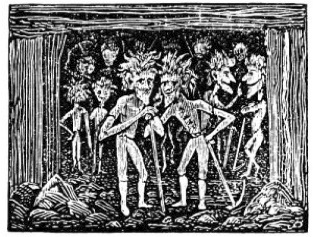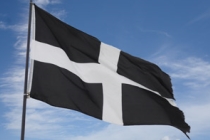The Faeries of the Cornish Tin Mines – Cousin Jack and the TommyKnockers

The tin mines of Cornwall have an ancient history that extends back into the mists of time. Cornish trade links with the Phoenicians and Carthaginians, which pre-date the arrival of the Romans in Britain, are documented by Greek historians. Around 2500 BC a trade started growing in tin and copper with these foreign traders exchanging bronze tools and gold ornaments for the minerals.
Faery faith and folklore has enjoyed a central role in the foundation and development of Celtic culture and Celtic Cornwall has many myths and legends involving Faeries which include a particularly Cornish variant in the form of the Faeries of the tin mines. These strange subterranean residents of Cornish mines are known by various names, one of the most common being Knockers (TommyKnockers). Over the centuries the legends surrounding these creatures became imbedded in the folklore and Faery faith of the Celtic miners to a remarkable degree. These folkloric traditions then followed the Cornish immigrants as they fanned out as prized mine workers around the world.
Patricia Monaghan in "The Encyclopaedia of Celtic Mythology and Folklore” gives us an amusingly detailed entry describing the Faeries of the mines as follows:
…strange knockings were sometimes heard on mineshaft walls. Nobody appeared after the unearthly rapping, for the invisible knockers were the ghost of long dead miners...The Knockers were not dangerous but helpful, their knocking growing louder when miners came near a rich vein of ore. They were private creatures who did not appreciate being spied upon. One man who did so, by the name of Barker, managed to learn their Faery language sufficiently to hear them express their annoyance at his presence, and their plan to leave their Faery tools on his knee, hence the Cornish proverb ‘stiff as Barker’s knee.
James MacKillop in his “Dictionary of Celtic Mythology” describes the Knockers as:
Cornish mine-spirits, thought to be the ghosts of the Jews who worked the mines in the 11th and 12th centuries. For the most part the gnomelike Knocker is thought harmless when out of sight of humans and cannot endure the sign of the cross.
MacKillop then points to a Welsh relative of the Knocker known as the Coblynau:
Welsh mine goblins, not unlike the Knockers of Cornwall. Although usually seen as quite ugly and standing only 18 inches high, they are perceived as being friendly and helpful. That know where rich lodes of ore may be found.

In the sources a pattern emerges of the Knocker as a mostly benevolent being but prone to the short fuse attributed to all Faeries when vexed by humans. Another theme is that of the Knocker warning the miners of an impending mine collapse. The notion that Knockers acted as protectors of the miners and were instrumental to their safety was an integral part of the folklore of the immigrant mining community in California that sprang up at the time of the Gold Rush and which resulted in a startling legal action connected with a 1956 mine closure.
The California county of El Dorado has posted on their web page a history of the success of Cornish miners in this area of the state, the origin of the term “Cousin Jack” and a tribute to the enduring legacy of the Faeries of the mines:
Their sudden success (Cornish miners) encouraged mine owners to ask if they knew of anyone else back home with mining experience who’d be interested in coming to work in the California mines. The common answer among the Cornish was… “Well, me cousin Jack over in Cornwall wouldst come could ye pay is boat ride." So many Cornish miners made their way to California this way, that it wasn’t long before the Americans had taken to calling em’ all… “Cousin Jacks.” The Cornish miners were highly respected and sought after making them the authority in many Northern California mines. As they educated many on mining they also inadvertently introduced the TommyKnockers to California…part of Cornish legend and lore which still survives today in our own mining culture and history. To the cousin Jacks the TommyKnockers were no less important than a candle and double jack…the cousin Jacks refused to enter any mine until the mining company assured them the TommyKnockers were on duty. In time mine owners gave way to the custom as simply a matter of doing business with the Cornish. If someone’s hammer was missing it was the TommyKnockers. If a cousin Jack got out just before the tunnel failed, you can bet it was the TommyKnockers who raised hell, got him out and saved his life.
In 1956 California’s mining industry came to a grinding halt. Devout believers (mostly Cornish descendants) lobbied the general manager of one of California’s largest and oldest mines, to release the TommyKnockers from employment in order so they could be transferred to other working mines in the California Mother Lode. The mining company agreed.
________
(1) The Encyclopedia of Celtic Mythology & Folklore: Patricia Monaghan: Checkmark Books: 2004
(2) Dictionary of Celtic Mythology: James MacKillop: Oxford University Press: 1998
(3) County of El Dorado, California web page: http://www.edcgov.us/Living.aspx?id=15039
(4) http://www.transceltic.com/irish/changelings-fairies-deities-and-saints-...
Content type:
- Cornish
Language:
- English
- Log in to post comments






